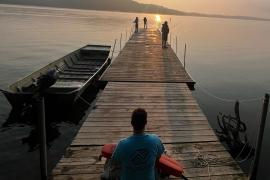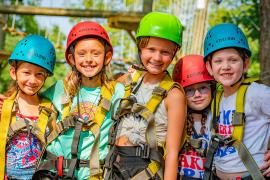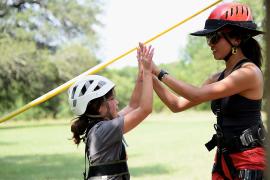If you are pivoting to online/virtual programming for part or all of your 2020 camp season, then you’re likely exploring how best to translate what you do physically in person at camp to an online/virtual forum without sacrificing the quality of your programming. Because, as you have no doubt witnessed firsthand, high-quality camp programs lead to better outcomes for youth. While many of us, including the American Camp Association (ACA), are just beginning the work of defining and mapping quality in online programming, some basic tenets — such as the importance of building strong relationships (mentor-mentee and peer-peer) and ensuring the personal and emotional safety of campers — remain central to achieving quality in virtual camp.
"Program quality refers to the ways camp staff practices, activities, and program climate foster youth development outcomes consistently over time," says Laurie Browne, PhD, the American Camp Association’s director of research. "A high-quality program consistently promotes youth development when participants feel the interactions are safe, inclusive, and invite them to make meaningful choices about their experience." This is true of in-person programming and online programming alike.
Incorporating the following into your virtual camp activities can help to ensure your virtual program includes the same marks of quality that your in-person program does (from ACA’s Designing Quality Youth Programs online course):
- Intentionally select program activities that provide one or more of the youth-development supports (supportive relationships, safety, youth involvement, skill building).
- Identify and improve ways in which campers are immersed in your camp’s program, philosophy, traditions, and mission.
- Examine ways to enhance campers' feelings of physical and emotional safety.
- Create meaningful new practices in which youth feel involved in decision-making and leadership opportunities.
- Evaluate activity plans to see how they provide challenges, support, and reinforcement of your camp’s mission.
When the American Diabetes Association (ADA) began planning their virtual program with an eye toward maintaining the quality of their traditional format, Kelly Mueller, MS, PMP, vice president of community impact at the ADA, says they began with three major metrics: reducing feelings of isolation, providing education, and building confidence/empowerment. "We asked ourselves, ‘What can we do virtually to achieve these metrics, and what’s impossible?’ Once we got a concept down, we concentrated on safety." That meant reviewing the Children’s Online Privacy Protection Act (COPPA) standards as well as safety standards of their chosen social media platform(s) and then designing their program to meet those standards.
The ADA also made sure to modify their code of conduct and camp waiver to reflect their new online format and give the child permission to participate and recognized the need to add online safety to the pre-camp training their counselors receive.
"Safety will be paramount, so there will have to be pretty regular interaction and check-ins for youth," says Kristin Moore, PhD, senior scholar with Child Trends.
Staff training, too, remains critical for camper well-being during online/virtual camp programming. Review and utilize ACA’s Camp Program Quality Assessment Short Form Checklist (2013) for staff best practices.
"At the heart of any program quality work, including virtual programming, are relationships," says Browne.
Mueller says the ADA has invited all ADA campers as well as campers who generally attend non-ADA diabetes camps to participate and is utilizing virtual cabins, small groups online, to encourage new friendships and interactive online activities that will also allow campers to reconnect with old friends.
The Search Institute (2020a) says of relationship building: "Staff in schools and youth programs do not need to and should not stop seeking to build developmental relationships with young people while they are at home during the nation’s response to the COVID-19 crisis."
The Search Institute further says that online camp staff can take steps to make "a valuable contribution to helping young people weather this storm," and suggests staff could ask campers how they are feeling about the world, themselves, and the future, and let them know they’ve really been heard and their feelings matter; or show campers respect by asking for their participation in creating rules and norms the group should follow while working together remotely (2020a).
Fear, which many of us feel from present coronavirus circumstances, can be a deterrent to building relationships. The Search Institute (2020b) offers suggestions for alleviating and even using fears as learning opportunities. Consider these techniques, among others, in your group forums online:
- Take time to listen intently to campers’ concerns, questions, and ideas related to the COVID-19 pandemic. Don’t dismiss their fears but seek to understand their source. Take time during virtual group sessions to check in and maintain relationships.
- Use this crisis as an opportunity to develop your campers’ critical thinking skills. "When young people talk about or spread rumors, misinformation, and conspiracy theories, push them to dig for accurate information, scientific research, and credible sources to clarify the issues."
- If you come across campers and/or camp staff who are experiencing prejudice or discrimination because of COVID-19, find ways to stand in solidarity with them and encourage others to do the same. Be vigilant about ensuring online interactions remain supportive, and deal with negative interactions in healthy ways.
Janice Toben, M Ed, co-founder of and curriculum developer for the Institute for Social and Emotional Learning, suggests a REALM system to ensure quality and engaged learning experiences that can easily be translated to virtual camp (Toben, 2020):
- Realm: Start and end with opening and closing rituals. Rituals provide a grounded and predictable form for connection, much like a nightly campfire or song at camp. "Repeated over time, rituals invoke meaning and create a space for campers to enter each day," says Toben.
- Energize: Pausing to be "off-task" for a few minutes through stretching, dancing, or another physical exercise can encourage more on-task behavior, not less, during an online activity/lesson.
- Appreciation and gratitude: "Gratitude and practices of appreciation have been shown to physiologically increase our sense of well-being. Being grateful can become a contagious mindset and will help connect your [campers] to each other," Toben says.
- Lighten: She also suggests that offering playful interactions in the face of the seriousness of the COVID-19 pandemic can increase motivation and help your group bond together.
- Mindfulness: Practicing mindfulness — being present in the moment and aware of one’s emotions, sensations, and insights — "can help people feel more at peace, become less stressed, and shift perspective," Toben says.
It is also important to note that equity and access are crucial components of quality programs to ensure everyone has a seat at the virtual table. Mueller says there are a couple levels to this. "For anything online, do the things that make online more accessible, such as using captions and descriptions." The ADA is also sending a care package to participants, including a camp T-shirt to promote solidarity and an activity journal, a workbook that allows campers to participate offline. This also encourages campers to step away from the computer for more self-directed activities outside.
"We’re actually calling our program ‘Camp at Home,’" says Mueller. "Virtual camp implies sitting in front of a computer all day. We’re building a mix of online interactivity and getting outside for activities. The activity journal is like a workbook of fun."
Moore further suggests, "Kids will probably be behind in school, so ways to move forward with formal learning seems really important, even if it is just for a couple of 20- to 30-minute time periods each day."
While the task of creating a quality online/virtual camp program may seem daunting, don’t let the change of venue overwhelm you. Use the many resources at your disposal and look for ways to translate what you already know works to the virtual world. And, remember, the bulk of your campers will probably feel quite at home in the online format.
Additional Resources
- Institute for Social and Emotional Learning: A New REALM: IFSEL’s Tips for Distance Learning
- Search Institute:
- David P. Weikart Center for Youth Program Quality
- Previous ACA Now blog posts related to online/virtual camp programming:
References
- American Camp Association. (2013). Camp program quality assessment short form checklist. ACA. Retrieved from www.ACAcamps.org/sites/default/files/resource_library/research/CPQA-sho…
- Search Institute. (2020a). Checklist: Building developmental relationships during the COVID-19 crisis. Retrieved from www.search-institute.org/wp-content/uploads/2020/03/Coronavirus-checkli…
- Search Institute. (2020b). Tip Sheet: 10 ways to respond to fear and scapegoating during the coronavirus epidemic. Retrieved from www.search-institute.org/wp-content/uploads/2020/03/SI-coronavirus-tips…
- Toben, J. (2020, March 16). A new REALM: IFSEL’s tips for distance learning. Institute for Social and Emotional Learning. Retrieved from https://www.instituteforsel.net/posts/realm
A special thank you to Kelly Mueller, vice president of community impact at the American Diabetes Association, and Kristin Moore, senior scholar with Child Trends.
The views and opinions expressed by contributors are their own and do not necessarily reflect the views of the American Camp Association or ACA employees.




